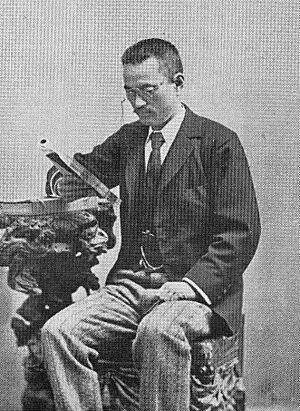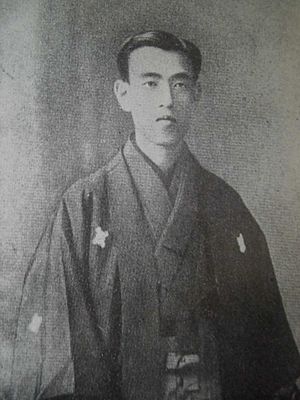Kafū Nagai facts for kids
Quick facts for kids
Kafū Nagai
|
|
|---|---|

Kafū Nagai in 1947
|
|
| Born | Sōkichi Nagai 3 December 1879 Tokyo, Japan |
| Died | 30 April 1959 (aged 79) Ichikawa, Japan |
| Occupation | Writer, translator, editor |
| Education | Junior High School |
| Literary movement | Naturalism, Aestheticism |
Kafū Nagai (永井 荷風, Nagai Kafū, 3 December 1879 – 30 April 1959) was a famous Japanese writer. He was also an editor and translator. His stories, like Geisha in Rivalry and A Strange Tale from East of the River, often showed the lively life of entertainers and artists in Tokyo during the early 1900s.
Contents
Kafū Nagai's Life
Kafū Nagai was born Sōkichi Nagai in Koishikawa, Bunkyō, Tokyo. This was on December 3, 1879. He was the oldest son of Kyūichirō Nagai and his wife Tsune. His father was a government official who had studied in the United States. He also wrote Chinese poetry.
Kyūichirō later left his government job. He started working for the Nippon Yusen shipping company. When Kafū's younger brother was born in 1883, Kafū went to live with his grandmother. He stayed with her until 1886.
Early Years and Education
As a child, Kafū went to a Chinese language school. His mother also taught him singing and how to play music. He especially liked utazawa, a style of singing from the Edo era. This music was often played with the shamisen, a Japanese string instrument. From 1890, he also began learning English.
In 1895, Kafū was sick and spent several months in a hospital in Odawara. He finished Junior High School in 1897. That same year, he visited Shanghai with his mother and brothers. His father was working there for Nippon Yusen. Kafū returned to Japan in the autumn and joined the Tokyo School of Foreign Languages.
Becoming a Writer
In 1898, Kafū published his first short story, Sudare no tsuki. He became a student of famous writers like Hirotsu Ryūrō and Fukuchi Ōchi. He also studied rakugo (storytelling) and kabuki (theater) playwriting. He even performed on stage in yose plays. Because of his passion for writing and performing, he left the University.
Kafū's writing was influenced by French Naturalism. This style of writing tries to show life as it really is, even the difficult parts. He was especially inspired by the French writer Émile Zola, whose books he also translated into Japanese.
Between 1903 and 1908, Kafū traveled to the United States and then to France. His father helped him make these trips. He wrote about his experiences in American Stories (Amerika monogatari) and Furansu monogatari (which means "French Stories"). When American Stories was published in 1908, many people praised it.
Later Career and Important Works
In 1910, Kafū Nagai started teaching literature at Keio University. He also became the editor of a literary magazine called Mita Bungaku. Around this time, he changed his writing style. He moved away from Naturalism and began writing in a style called Aestheticism. This style focuses more on beauty and art.
The time when Japan moved from the Meiji era to the Taishō era was a big change for Kafū. His father passed away, and he divorced both his first and second wives. His second marriage was to a geisha, which caused problems with his mother. He also left his job at Keio University and Mita Bungaku.
Kafū often visited the lively entertainment areas of Tokyo. He wrote many stories about the people who lived and worked there. His most famous work from this period is Geisha in Rivalry (1916–17).
After not publishing much for ten years, he released new stories. These included During the Rains (1931), Flowers in the Shade (1934), and A Strange Tale from East of the River (1937). Many people consider A Strange Tale from East of the River to be his most important work.
Kafū did not agree with the government's military ideas during World War II. The government thought his writings were against their efforts. Because of this, his works were not published until after the war ended. His diaries, which he wrote from 1917 to 1959, became a very important literary event after the war.
In 1952, Kafū Nagai received the Order of Culture. This is a very high honor in Japan. In 1954, he became a member of the Japan Art Academy. Kafū Nagai passed away on April 30, 1959.
Selected Works
- 1908: American Stories (あめりか物語, Amerika monogatari)
- 1911: The River Sumida (すみだ川, Sumidagawa)
- 1916–1917: Geisha in Rivalry (腕くらべ, Ude kurabe)
- 1917–1959: Danchōtei nichijō (断腸亭日乗)
- 1931: During the Rains (つゆのあとさき, Tsuyu no atosaki)
- 1934: Flowers in the Shade (ひかげの花, Hikage no hana)
- 1937: A Strange Tale from East of the River (濹東綺譚, Bokutō kidan)
See also
 In Spanish: Kafū Nagai para niños
In Spanish: Kafū Nagai para niños



